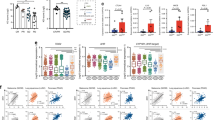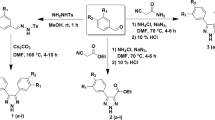Abstract
T lymphocytes undergo proliferation arrest when exposed to tryptophan shortage, which can be provoked by indoleamine 2,3-dioxygenase (IDO), an enzyme that is expressed in placenta and catalyzes tryptophan degradation. Here we show that most human tumors constitutively express IDO. We also observed that expression of IDO by immunogenic mouse tumor cells prevents their rejection by preimmunized mice. This effect is accompanied by a lack of accumulation of specific T cells at the tumor site and can be partly reverted by systemic treatment of mice with an inhibitor of IDO, in the absence of noticeable toxicity. These results suggest that the efficacy of therapeutic vaccination of cancer patients might be improved by concomitant administration of an IDO inhibitor.
This is a preview of subscription content, access via your institution
Access options
Subscribe to this journal
Receive 12 print issues and online access
$209.00 per year
only $17.42 per issue
Buy this article
- Purchase on Springer Link
- Instant access to full article PDF
Prices may be subject to local taxes which are calculated during checkout




Similar content being viewed by others
References
Mellor, A.L. & Munn, D.H. Tryptophan catabolism and T-cell tolerance: immunosuppression by starvation? Immunol. Today 20, 469–473 (1999).
Munn, D.H. et al. Prevention of allogeneic fetal rejection by tryptophan catabolism. Science 281, 1191–1193 (1998).
Munn, D.H. et al. Inhibition of T cell proliferation by macrophage tryptophan catabolism. J. Exp. Med. 189, 1363–1372 (1999).
Hwu, P. et al. Indoleamine 2,3-dioxygenase production by human dendritic cells results in the inhibition of T cell proliferation. J. Immunol. 164, 3596–3599 (2000).
Kudo, Y., Boyd, C.A., Sargent, I.L. & Redman, C.W. Tryptophan degradation by human placental indoleamine 2,3-dioxygenase regulates lymphocyte proliferation. J. Physiol. 535, 207–215 (2001).
Frumento, G., Rotondo, R., Tonetti, M. & Ferrara, G.B. T cell proliferation is blocked by indoleamine 2,3-dioxygenase. Transplant. Proc. 33, 428–430 (2001).
Fallarino, F. et al. Functional expression of indoleamine 2,3-dioxygenase by murine CD8α+ dendritic cells. Int. Immunol. 14, 65–68 (2002).
Takikawa, O., Kuroiwa, T., Yamazaki, F. & Kido, R. Mechanism of interferon-gamma action. Characterization of indoleamine 2,3-dioxygenase in cultured human cells induced by interferon-gamma and evaluation of the enzyme-mediated tryptophan degradation in its anticellular activity. J. Biol. Chem. 263, 2041–2046 (1988).
Habara-Ohkubo, A., Takikawa, O. & Yoshida, R. Cloning and expression of a cDNA encoding mouse indoleamine 2,3- dioxygenase. Gene 105, 221–227 (1991).
Munn, D.H. et al. Potential regulatory function of human dendritic cells expressing indoleamine 2,3-dioxygenase. Science 297, 1867–1870 (2002).
Friberg, M. et al. Indoleamine 2,3-dioxygenase contributes to tumor cell evasion of T cell-mediated rejection. Int. J. Cancer 101, 151–155 (2002).
Grohmann, U. et al. CTLA-4-Ig regulates tryptophan catabolism in vivo. Nature Immunol. 3, 1097–1101 (2002).
Van den Eynde, B., Lethé, B., Van Pel, A., De Plaen, E. & Boon, T. The gene coding for a major tumor rejection antigen of tumor P815 is identical to the normal gene of syngeneic DBA/2 mice. J. Exp. Med. 173, 1373–1384 (1991).
Brändle, D. et al. The shared tumor-specific antigen encoded by mouse gene P1A is a target not only for cytolytic T lymphocytes but also for tumor rejection. Eur. J. Immunol. 28, 4010–4019 (1998).
Medema, J.P. et al. Blockade of the granzyme B/perforin pathway through overexpression of the serine protease inhibitor PI-9/SPI-6 constitutes a mechanism for immune escape by tumors. Proc. Natl. Acad. Sci. USA 98, 11515–11520 (2001).
Pawelec, G. et al. Escape mechanisms in tumor immunity: a year 2000 update. Crit. Rev. Oncog. 11, 97–133 (2000).
Marincola, F., Jaffee, E.M., Hicklin, D.J. & Ferrone, S. Escape of human solid tumors from T-cell recognition: molecular mechanisms and functional significance. Adv. Immunol. 74, 181–273 (2000).
Cady, S.G. & Sono, M. 1-Methyl-DL-tryptophan, β-(3-benzofuranyl)-DL-alanine (the oxygen analog of tryptophan), and β-[3-benzo(b)thienyl]-DL-alanine (the sulfur analog of tryptophan) are competitive inhibitors for indoleamine 2,3-dioxygenase. Arch. Biochem. Biophys. 291, 326–333 (1991).
Kudo, Y. & Boyd, C.A. Human placental indoleamine 2,3-dioxygenase: cellular localization and characterization of an enzyme preventing fetal rejection. Biochim. Biophys. Acta 1500, 119–124 (2000).
Kudo, Y. & Boyd, C.A. Characterisation of L-tryptophan transporters in human placenta: a comparison of brush border and basal membrane vesicles. J. Physiol. 531, 405–416 (2001).
Prætorius-Ibba, M. et al. Ancient adaptation of the active site of tryptophanyl-tRNA synthetase for tryptophan binding. Biochemistry 39, 13136–13143 (2000).
Jorgensen, R., Sogaard, T.M.M., Rossing, A.B., Martensen, P.M. & Justesen, J. Identification and characterization of human mitochondrial tryptophanyl-tRNA synthetase. J. Biol. Chem. 275, 16820–16826 (2000).
Terness, P. et al. Inhibition of allogeneic T cell proliferation by indoleamine 2,3-dioxygenase-expressing dendritic cells: mediation of suppression by tryptophan metabolites. J. Exp. Med. 196, 447–457 (2002).
Fallarino, F. et al. T cell apoptosis by tryptophan catabolism. Cell Death Differ. 9, 1069–1077 (2002).
Van den Eynde, B. & van der Bruggen, P. T cell-defined tumor antigens. Curr. Opin. Immunol. 9, 684–693 (1997).
Boon, T. & Van den Eynde, B. Tumor immunology—editorial overview. Curr. Opin. Immunol. 15, 129–130 (2003).
Nestle, F.O. et al. Vaccination of melanoma patients with peptide- or tumor lysate-pulsed dendritic cells. Nat. Med. 4, 328–332 (1998).
Rosenberg, S.A. et al. Immunologic and therapeutic evaluation of a synthetic peptide vaccine for the treatment of patients with metastatic melanoma. Nat. Med. 4, 321–327 (1998).
Marchand, M. et al. Tumor regressions observed in patients with metastatic melanoma treated with an antigenic peptide encoded by gene MAGE-3 and presented by HLA-A1. Int. J. Cancer 80, 219–230 (1999).
Thurner, B. et al. Vaccination with MAGE-3A1 peptide-pulsed mature, monocyte-derived dendritic cells expands specific cytotoxic T cells and induces regression of some metastases in advanced stage IV melanoma. J. Exp. Med. 190, 1669–1678 (1999).
Jäger, E. et al. Induction of primary NY-ESO-1 immunity: CD8+ T lymphocyte and antibody responses in peptide-vaccinated patients with NY-ESO-1+ cancers. Proc. Natl. Acad. Sci. USA 97, 12198–12203 (2000).
Suzuki, S. et al. Expression of indoleamine 2,3-dioxygenase and tryptophan 2,3- dioxygenase in early concepti. Biochem. J. 355, 425–429 (2001).
Uno, T., Chen, P.W., Murray, T.G., Podack, E.R. & Ksander, B.R. Gene transfer of the CD80 costimulatory molecule into ocular melanoma cells using a novel episomal vector. Invest. Ophtalmol. Vis. Sci. 38, 2531–2539 (1997).
Wenkel, H., Chen, P.W., Ksander, B.R. & Streilein, J.W. Immune privilege is extended, then withdrawn, from allogeneic tumor cell grafts placed in the subretinal space. Invest. Opthalmol. Vis. Sci. 40, 3202–3208 (1999).
Lethé, B., Van den Eynde, B., Van Pel, A., Corradin, G. & Boon, T. Mouse tumor rejection antigens P815A and P815B: two epitopes carried by a single peptide. Eur. J. Immunol. 22, 2283–2288 (1992).
Van Pel, A., De Plaen, E. & Boon, T. Selection of a highly transfectable variant from mouse mastocytoma P815. Som. Cell Genet. 11, 467–475 (1985).
Bilsborough, J. et al. TNF-mediated toxicity after massive induction of specific CD8+ T cells following immunization of mice with a tumor-specific peptide. J. Immunol. 169, 3053–3060 (2002).
Van den Eynde, B. et al. A new family of genes coding for an antigen recognized by autologous cytolytic T lymphocytes on a human melanoma. J. Exp. Med. 182, 689–698 (1995).
Acknowledgements
We thank J. Bilsborough, S. Buonocore, F. Brasseur, P. Camby, D. Donckers, C. Jacques, B. Lethé, F. Piette and G. Warnier for help at various steps of the work; S. Depelchin for editorial assistance; and P. Coulie and P. van der Bruggen for critical reading of the manuscript. This work was supported in part by a grant from FB Assurances and VIVA (Belgium), and by grants QLG1-CT-1999-00622, QLK2-CT-1999-00556 and QLK2-CT-1999-00318 from the Fifth Framework programme of the European Community.
Author information
Authors and Affiliations
Corresponding author
Ethics declarations
Competing interests
The authors declare no competing financial interests.
Rights and permissions
About this article
Cite this article
Uyttenhove, C., Pilotte, L., Théate, I. et al. Evidence for a tumoral immune resistance mechanism based on tryptophan degradation by indoleamine 2,3-dioxygenase. Nat Med 9, 1269–1274 (2003). https://doi.org/10.1038/nm934
Received:
Accepted:
Published:
Issue Date:
DOI: https://doi.org/10.1038/nm934
This article is cited by
-
Phase I/II trial of BMS-986,205 and nivolumab as first line therapy in hepatocellular carcinoma
Investigational New Drugs (2024)
-
L-kynurenine induces NK cell loss in gastric cancer microenvironment via promoting ferroptosis
Journal of Experimental & Clinical Cancer Research (2023)
-
Uterine microbial communities and their potential role in the regulation of epithelium cell cycle and apoptosis in aged hens
Microbiome (2023)
-
High expression of IL4I1 is correlated with poor prognosis and immune infiltration in thyroid cancer
BMC Endocrine Disorders (2023)
-
Identification of predictive biomarkers for endometrial cancer diagnosis and treatment response monitoring using plasma metabolome profiling
Cancer & Metabolism (2023)



